Author: Cade Jobe
It’s a simple fact that without yeast, there is no beer, and as such, it makes sense that brewers would invest effort into ensuring their yeast is as healthy as possible. A primary measure of yeast health is viability, which refers to the number of living cells in a given population. While many labs have begun selling “pitchable” amounts of yeast, it may still fall short for certain stronger styles, so rather than pitching another pouch, some opt to propagate yeast in a starter to improve viability.
Through evolution, yeast have developed the ability to generate energy in the absence of oxygen in a process called fermentation, during which approximately 2 energy units (ATP) per glucose molecule are produced. However, yeast can also rely on respiration when oxygen is present, which produces more than 30 ATP per glucose molecule, but only when the solution contains less than 2 g/L of glucose. This is referred to as the Crabtree effect, a phenomenon that inspired researchers from Sierra Nevada Brewing Company to perform a fascinating study where they looked at the impact of forcing yeast down the respiration path by propagating in a lower-strength starter. The results were surprising– not only was cell replication better compared to yeast propagated in a standard-strength starter, but so was overall fermentation performance.
I was taught that starters ought to be around 1.040 OG in strength, which equates to approximately 100 grams of dry malt extract (DME) per liter of water. Through discussion with Dr. Maria Moutsoglou on episode 062 of The Brü Lab, I learned that yeast seem to benefit from propagation in lower strength starters around 1.008 OG, as it forces yeast to respire and generate far more energy. While I don’t have access to all the lab equipment necessary for objectively measuring viability, I was curious of the perceptible impact this approach might have and designed an xBmt to test it out.
| PURPOSE |
To evaluate the differences between a Munich Helles fermented with yeast propagated in a standard strength starter and one propagated in a low strength starter.
| METHODS |
In order to keep any impact of the variable front and center, I went with a simple Munich Helles recipe for this xBmt.
Deep Breath
Recipe Details
| Batch Size | Boil Time | IBU | SRM | Est. OG | Est. FG | ABV |
|---|---|---|---|---|---|---|
| 5.5 gal | 60 min | 23.9 | 3.3 SRM | 1.05 | 1.006 | 5.78 % |
| Actuals | 1.05 | 1.006 | 5.78 % | |||
Fermentables
| Name | Amount | % |
|---|---|---|
| Pelton: Pilsner-style Barley Malt | 11 lbs | 100 |
Hops
| Name | Amount | Time | Use | Form | Alpha % |
|---|---|---|---|---|---|
| Tettnang | 50 g | 60 min | Boil | Pellet | 3.9 |
Yeast
| Name | Lab | Attenuation | Temperature |
|---|---|---|---|
| Pilgrimage (L26) | Imperial Yeast | 77% | 32°F - 32°F |
Notes
| Water Profile: Ca 32 | Mg 12 | Na 36 | SO4 5 | Cl 10 |
Download
| Download this recipe's BeerXML file |
I started my brew day by collecting the full volume of water for each batch, adjusting both to my desired mineral profile, then setting the electric controllers to heat them up.
When the water was properly heated, I incorporated the milled grains, turned the pumps on to recirculate, and set the controllers to maintain my intended mash temperature of 152°F/67°C.
While the mashes were resting, I weighed out the kettle hop additions.
Following each 60 minute mash rest, I raised the grain baskets out of the kettles and let them drain. The worts were then boiled for 60 minutes with hops added at the times listed in the recipe.
When the boils were complete, I quickly chilled the wort then took hydrometer measurements showing both were at the same OG.
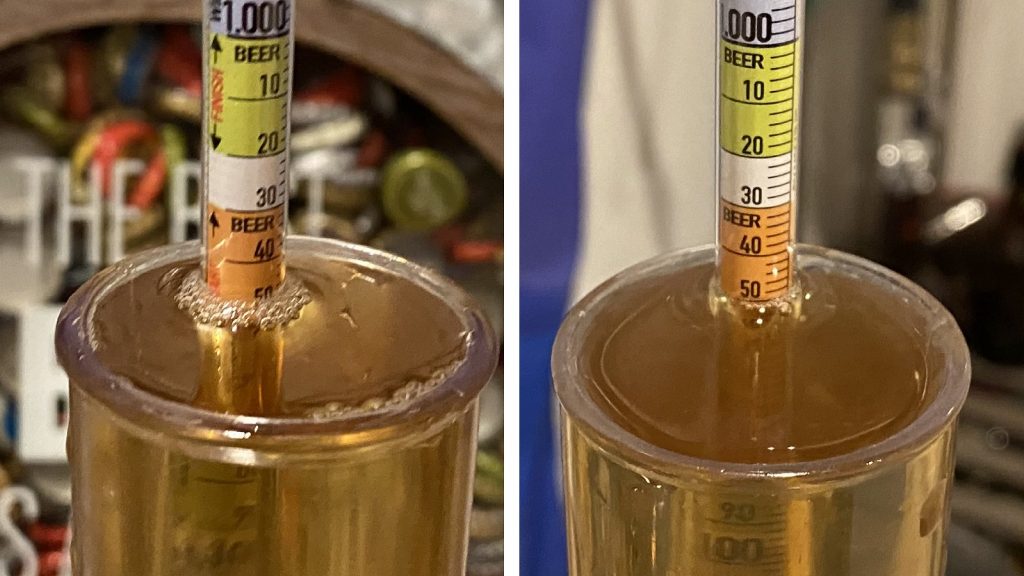
I transferred the worts to sanitized fermenters and placed them next to each other in my fermentation chamber to finish chilling, then I prepared the yeast starters. Using Brewfather to determine the strength of each starter, I measured out 192 grams of DME for the standard strength starter and just 43 grams for the low strength starter.
In keeping with the original Sierra Nevada study as well as Dr. Moutsoglou’s recommendation, I added the same amount of yeast nutrient to each starter.
Finally, I added identical amounts of RO water to each jar and swirled until the DME was completely dissolved before evenly splitting a 6 month old pouch of Imperial Yeast L26 Pilgrimage between them. According to pitch rate calculators, the viability of the yeast given its age was around 25%, meaning each starter received approximately 25 billion cells when the beer, considering OG and fermentation temperature, called for nearly 400 billion cells.
I observed the starters had noticeably different colors.
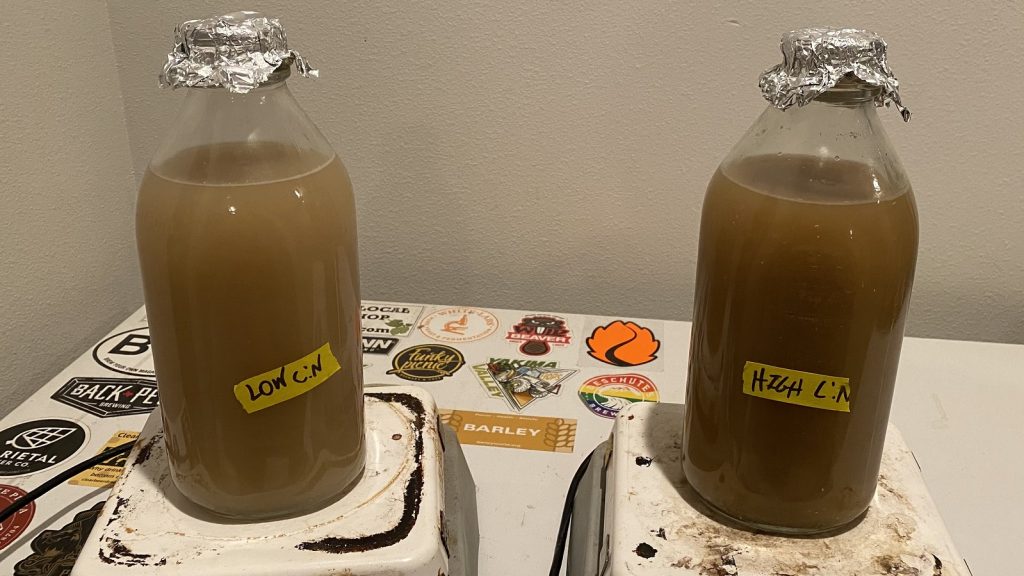
The following day, approximately 30 hours after making the starters, I pitched them into their respective worts, which had stabilized at my target fermentation temperature of 55°F/13°C. While I noticed fermentation activity in both beers 10 hours later, the one pitched with the low strength starter finished a day before the one pitched with a standard strength starter, and hydrometer measurements taken after 2 weeks showed it also finished 0.006 SG points lower than the standard strength starter beer.
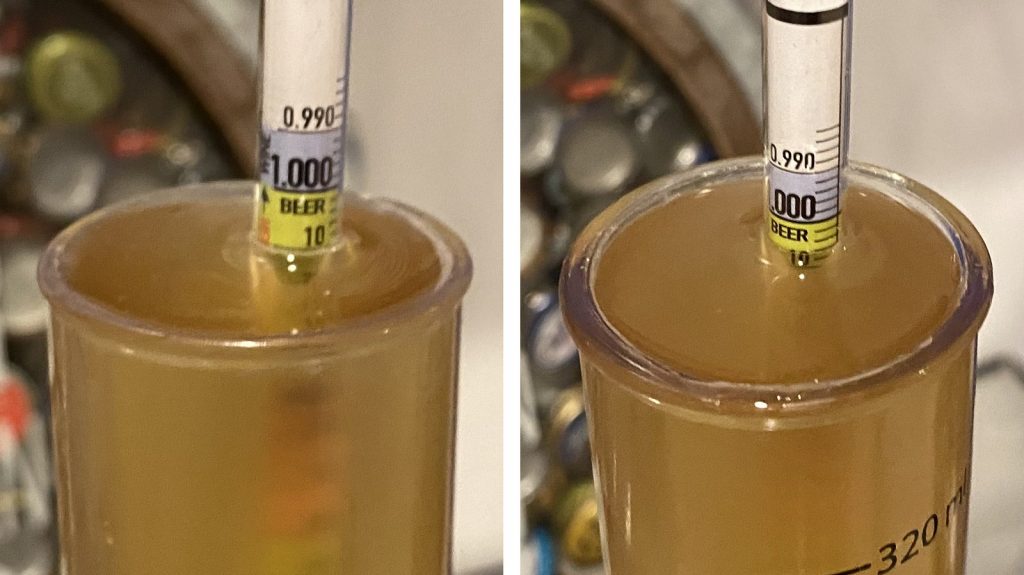
I proceeded to pressure transfer the beers to CO2 purged kegs.
The filled kegs were placed on gas in my keezer and allowed to condition for a couple of weeks before they were ready for evaluation.
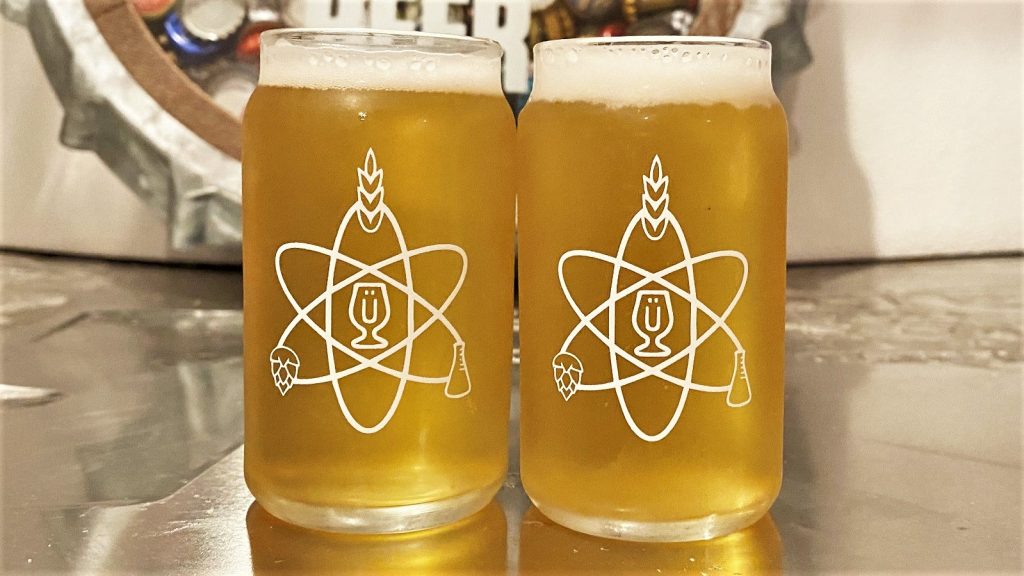
| RESULTS |
A total of 23 people of varying levels of experience participated in this xBmt. Each participant was served 1 sample of the beer pitched with a standard strength starter and 2 samples of the beer pitched with a low strength starter in different colored opaque cups then asked to identify the unique sample. While 12 tasters (p<0.05) would have had to accurately identify the unique sample in order to reach statistical significance, only 9 did (p=0.35), indicating participants in this xBmt were unable to reliably distinguish Munich Helles pitched with a standard strength starter from one pitched with a low strength starter.
My Impressions: Out of the 5 semi-blind triangle tests I attempted, I correctly identified the odd-beer-out just once, and that was admittedly a random guess. These beers were perceptibly identical to me, both being nicely malty with low floral hops and perhaps a touch too much bitterness for the style, but still enjoyable to drink.
| DISCUSSION |
Yeast starters are a simple tool used by brewers to increase yeast viability, and while the common recommendation is to propagate in 1.040 OG wort, recent evidence suggests that a lower wort strength of 1.008 OG can be equally as, if not more, effective. The fact tasters in this xBmt were unable to reliably distinguish a Munich Helles pitched with a standard strength starter from one pitched with a low strength starter suggests any impact was minimal enough as to be grossly imperceptible.
The sensory findings from this xBmt, while interesting, aren’t terribly surprising when viewed in light of past xBmts on yeast pitch rate. Rather, the differences in overall fermentation time and attenuation seem to support the efficacy of using low strength starters, as that beer was not only done fermenting a day before the beer pitched with a standard strength starter, but it also finished 0.006 SG points lower.
I’ve been brewing and researching all things beer for long enough at this point that it’s rare for me to learn of something that genuinely causes me to question what I thought I knew, but that’s exactly what happened during my chat with Dr. Maria Moutsoglou. While I don’t make many starters these days due to my preference for fresh Imperial Yeast, in those times where I feel one is warranted, I will definitely consider going with a lower OG wort and look forward to exploring this variable more in the future.
If you have any thoughts about this xBmt, please do not hesitate to share in the comments section below!
Support Brülosophy In Style!
All designs are available in various colors and sizes on Amazon!
Follow Brülosophy on:
FACEBOOK | TWITTER | INSTAGRAM
If you enjoy this stuff and feel compelled to support Brulosophy.com, please check out the Support page for details on how you can very easily do so. Thanks!


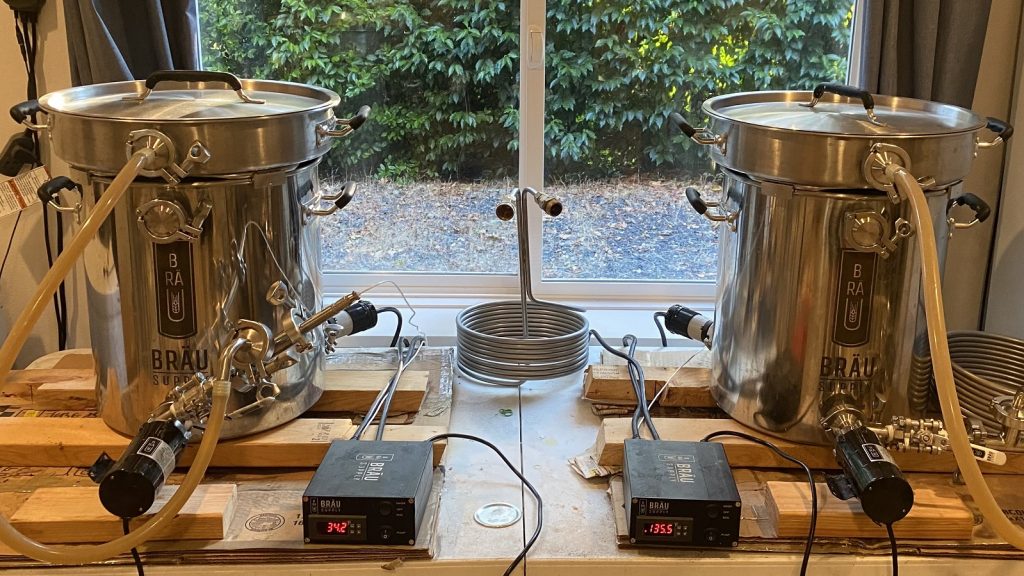
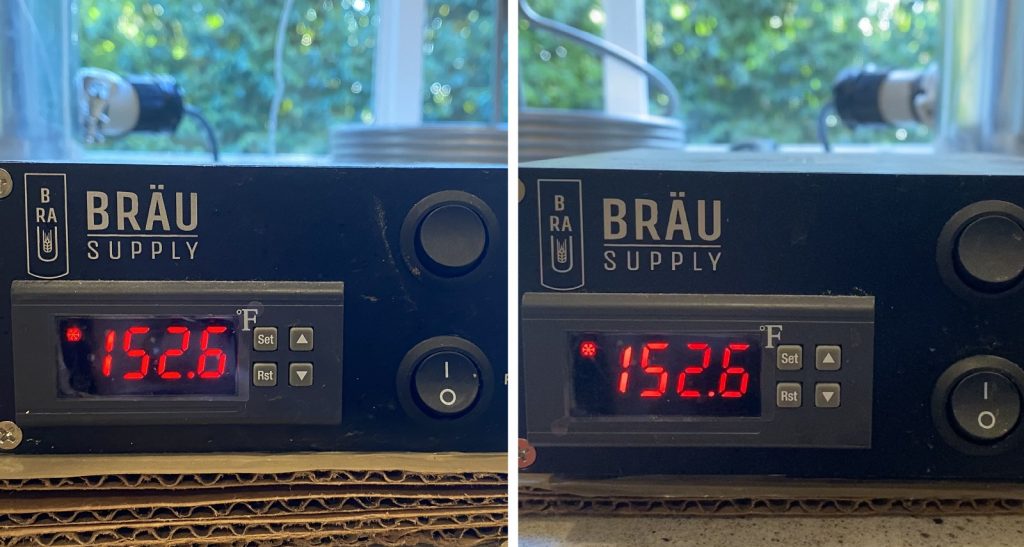
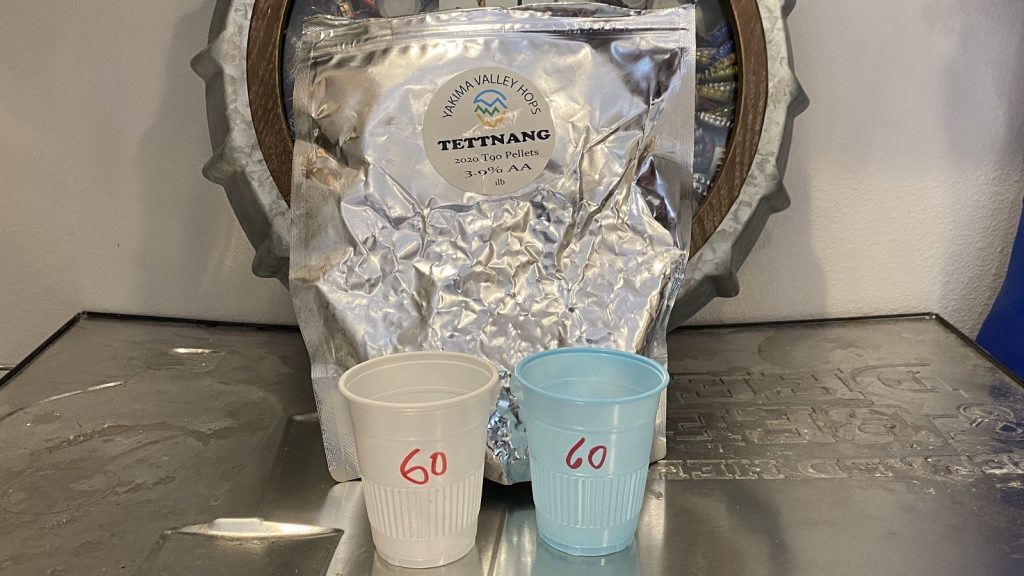
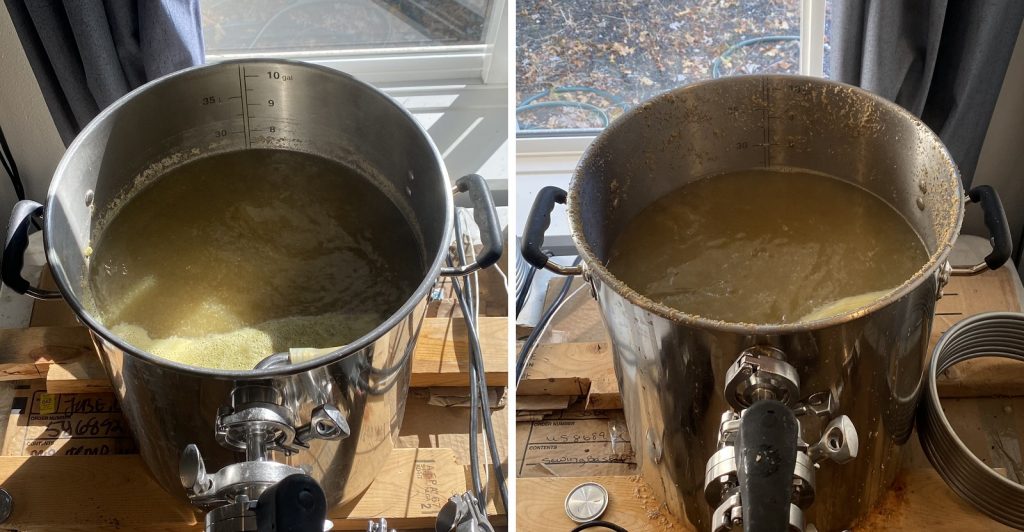
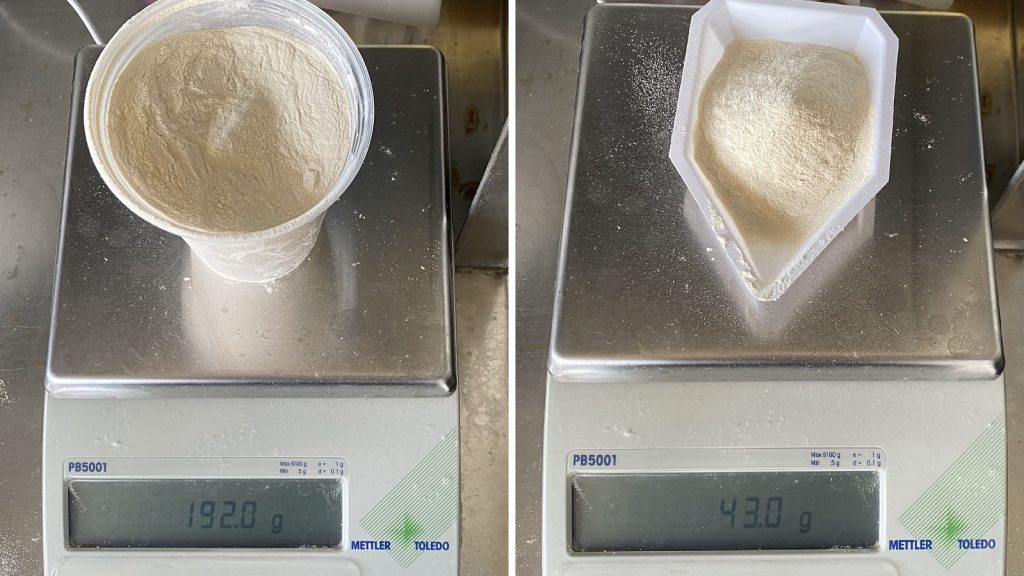
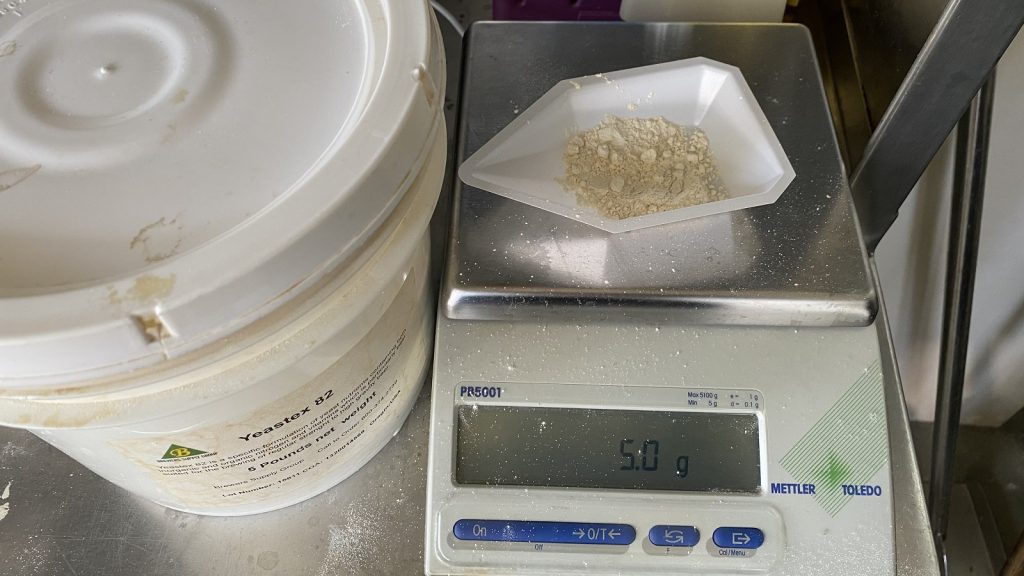
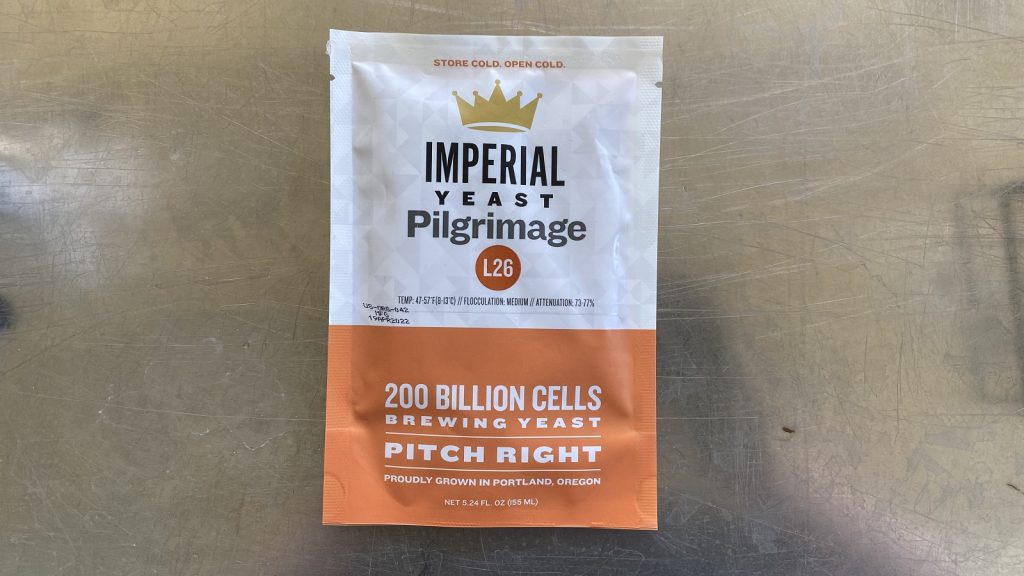
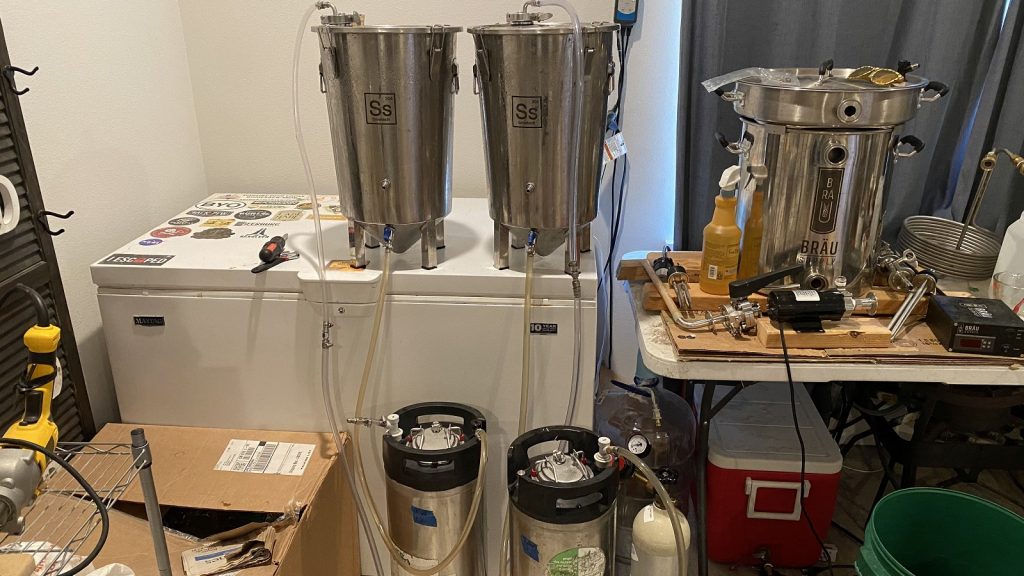











32 thoughts on “exBEERiment | Impact Yeast Starter Strength Has On A Munich Helles”
Great episode. One thing kept coming to my mind when you 2 were talking about the superior cell growth and health of a 1008 starter vs 1040: how low could we go at a homebrew scale before the increased risk of contamination is too high to be worth it? A 1008 starter is probably a sub 1% abv beer, I would assume that it is more susceptible to contamination.
Yeast still needs glucose for respiration, so you need to have some sugar in the solution. How low can you go? I don’t know, but I wouldn’t go much lower than 1.008.
Contamination is probably still a risk even at 1.040. When I make a vitality starter, my goal is to pitch yeast at their highest growth point, during the lag phase before they’ve produced enough alcohol to have a significant antimicrobial effect. I’ve never measured it, but I would guess the ABV is sub 1% at pitch, even in a 1.040 starter because I’m not letting it go all the way to terminal gravity.
I always drop a couple of hop pellets into each starter to help prevent infections.
I typically use starter calculators as a guide for my brews, but this episode has me wondering if the standard pitch rates we have been using are not as important as first thought. Either that or for optimal yeast health starters will have to be 5 times the size using low OG solution. I am actually quite curious how the results of this test will change conventional thinking about yeast in the future.
There’s nothing in Maria Moutsoglou’s paper that suggests making a lower gravity starter of a certain volume in lieu of a higher (standard) gravity starter *of that same volume.* Nor did *she* ever say this in the podcast. I’d recommend a careful reading of the paper before designing any further experiments around it.
A reasonable experiment based on the paper would be to make two identical starters of standard gravity. Then dilute one of those starters down to 2°P and add additional Nitrogen. i.e. don’t reduce the total sugars…dilute their concentration (in a higher volume of water) to reduce the crabtree effect and thus increase the efficiency of the fixed amount of sugars..
I’m not sure that I follow you. There’s no difference in sugar content when making a 2P starter vs making a 10P starter and diluting it to 2P with a higher volume of water…the extract/sugar content is 2P.
When you make a 10P starter, of say 1 liter, and dilute it to 2P, you have more total sugar than if you had made a 2P starter of 1 liter. The concentrations are the same, but the total sugar is not. This experiment tested *something*, perhaps something useful, but I don’t think it was something suggested by Maria Moutsoglou’s research.
The “headline” if you will from her paper was “Propagation in low C:N wort with 2°P sugar yielded a 27% decrease in fermentation efficiency and a 46% increase in cell production compared to 2°P high C:N wort.” Note that the headline was not a comparison of low gravity to high gravity starters of the same volume. Her research is all about finessing more efficiency “per sugar unit” per se by reducing the crabtree effect and increasing respiration. To make that happen, you have to dilute the wort. But she’s not suggesting that a 2P starter of a certain volume results in more (or as many) cells as a normal gravity starter of the same volume.
I’m still not following…the problem is that there aren’t enough sugar molecules in the 2L 1.008 starter? Starter volume is definitely important; there has to be enough sugar for the yeast to survive and grow, but targeting the appropriate concentration (i.e. 2P or 10P) was the focus of this experiment. Are you saying that the yeast don’t have enough sugar in the 2L 1.008 starter? Am I on track or way off what you’re trying to say?
Also, it bears repeating that this exBEERiment is not a copy of Dr. Moutsoglou’s experiment. One of the takeaways from her work is that forcing yeast starter down the respiration pathway may allow for more vigorous growth and better fermentation performance. This exBEERiment was inspired by that takeaway.
“I’m still not following…the problem is that there aren’t enough sugar molecules in the 2L 1.008 starter? ”
I’m saying that a 1.008 starter of ‘X’ volume won’t produce the same cell count as a “standard” gravity starter of that same ‘X’ volume. Although the 1.008 starter (with enough nitrogen) will be more efficient *per gram of sugar* due to some fermentation being replaced with respiration, it won’t have enough sugar to beat the standard starter of the same volume. For the 2P starter to make as many cells as the 8P starter, it would have to be *4 time as as efficient* per gram of sugar. But it’s not. See figure 2-B in the paper.
its definitely the same amount of sugar. You can have 1 dollar then split it into 100 pennies for 100 people, or just have 1 penny.
Are we missing something? The hydrometer measures the density of the liquid by displacing the instrument from the effect of increased or decreased sugar.
I THINK what Mick is trying to say is that if you take 1L of 10°P and dilute it to 2°P, you now have 5L of 2°P starter. Although a single liter of that 10°P wort diluted to 2°P will have the same amount of sugar as 1L of non-diluted 2°P wort, since you have 5 times as much of the diluted wort, there is 5 times as much total sugar. I think he’s suggesting a test of 2 starters with equal amounts of malt extract, but one that 5x the volume of the other. I guess you’d also have to decant those starters to reduce the impact of the extra liquid in the 5L starter.
I just re-read her paper, I think I get what you’re saying.
The way I understand it is, if I take 100g DME in 1L I get, roughly 1.035SG (about 8.8ºP) which is pretty standard. If I then add 3 L of water I have roughly 1.007SG (about 1.8ºP) because that 100g DME is now diluted in 4L rather than 1L.
The total sugar is the same, 100g DME, but the diluted starter will be more efficient because it is diluted to avoid the crab-tree effect.
Basically, when doing low gravity starters, you need to make your starters 300% bigger in volume (same amount of sugar and yeast nutrient), which will result in healthier yeast/fermentation and a bit more yeast biomass. That efficiency increase won’t be enough to do a 1L starter at 1.007 instead of a 1L 1.035 one.
Recently, I’ve been trying to step-up from frozen vials using “normal” volumes but at the low gravity and ended up with stuck fermentations and yeast counts what were waaaay under what the yeast calcs (using standard wort) predicted.
If you’re stepping up from 15ml then the extra volume of low-gravity starters could actually make things more managable (it’s easier to put 500ml on a stirplate than 150ml for example).
This was interesting, thanks for posting. I’ll have to listen to this episode (haven’t listened since episode 31). It would have been interesting to know the cell numbers in each starter (at inoculation and at time of pitch). That said, it’s also interesting (I need a new word) that when you search terms like “pitch rate” or “starter” on this site the vast majority of experiments didn’t seem to produce beers that tasters could distinguish from each other. Cool stuff!
You did not mention the amount or product used to add Nitrogen to the 2P starter. From Episode 62 I understood the addition of Nitrogen from a yeast extract is important.
The product is Yeastex 82 and the amount I added was 5 g, which is in the picture, but not the text. When I get a chance, I’ll update the text. The information about how much to add is sparse so I was just trying to achieve “more nitrogen” than I could possibly need. Admittedly not the most scientific practice, but I didn’t want nitrogen limitation to be a factor.
In the paper they added 9g/L for the low C:N 2P wort. Different extract (hers is all organic source while I think yours is also inorganic) but a good starting point.
Hi Cade, nice article! I am curious what yeast nutrient product you used in this experiment? The yeast nutrient I buy is usually sold in about the 50g amount. I am curious if we use the same one.
Very interesting! If I remember the episode with Dr. Moutsoglou correctly, it seemed nitrogen was a pretty significant factor in the propagation experiment. I would have thought an experiment based on that episode would have used a higher concentration of nitrogen per volume of propagation media. A few commenters have mentioned it already, but could you provide more details about the type of yeast nutrient you used, why you chose that one, why you used 5g in 2L in both, etc?
You mention, “In keeping with the original Sierra Nevada study as well as Dr. Moutsoglou’s recommendation, I added the same amount of yeast nutrient to each starter.” So does that mean you talked to Dr. Moutsoglou again specifically to consult on this experiment and she gave you recommendations on how to design it? Or are you saying that what she said during the episode was the recommendation?
Cheers!
I spy a math error (or a typo). FG of 1.010 for the regular starter, and FG of 1.006 for the low concentration starter is a difference of .004, not .006.
Minor comments.
1. The wort in the Moutsoglu study is 1.013 (3.3P) not 1.008.
2. The nutrient added in the Moutsoglu study delivers a known amount of FAN; it’s unclear whether Yeastex 82 delivers FAN and if so, how much.
3. In the Moutsoglu study, the difference between the best and worst starters is 0.25P (0.001); you had a 1P (0.004) difference.
4. If your standard starter attenuates the beer 1P (0.004) less than your experimental starter, it suggest that all the beers you brewed in the past with the standard strength method could be significantly underattenuated.
Cheers!
1.050 to 1.006 means 88% apparent attenuation, which is way more than what Imperial suggests. The “normal” starter gave what I would consider normal attenuation; 79%. I’ve been using this yeast quite a few times, and have been getting plus/minus 80%, with a max of 83. Nowhere near 88.
Regarding the difference in the attenuation, I am guessing that Cade didn’t decant the starters, so the 2°P starter would have lowered the OG more than the 8°P starter. We don’t know the volumes of the starters, so there’s no way to verify this.
An other thought: As the two beers seem to be pretty identical, the difference in attenuation probably is not a difference in consumption of maltotriose, which would seem natural to me. Or … ? Would not the alternative be that the more efficient yeast had gobbled up some dextrins? But is that probable?
Why assume that a difference in attenuation is not due to a difference in consumption of maltotriose? With most yeasts/beers, that’s exactly what it’s due to. Also, take a look at the Maria Moutsoglou’s paper. The research found that residual *sugars* (not dextrins) were higher in beers made from high C:N produced yeast than in beers made from low C:N produced yeast.
Yeasts that use dextrins (i.e. “diastaticus” strains) can do it because they have a gene (STA1) that “normal” yeasts don’t. If you don’t have the gene to make the required enzymes, you can’t break down the dextrins.
As maltoriose has some sweetness, anbeit very little, my thought was that a difference in maltotriose consumption might make the beers taste slightly different, whereas a difference in detxrin content would not do that.
I quite agree that ability to break down dextrins is not something it’s likely a yeast may suddenly aquire:). It could of course not be caused by STA-1, as this yeast is STA-1 negative.
Yes, it’s likely that the difference in attenuation is related to maltotriose consumption. Worts of identical sugar composition should reach identical attenuation. Healthier yeast would get to final attenuation faster, but if both yeasts are sufficiently healthy, they should get to the same attenuation. An attenuation difference of 0.004 (1P) is very large and suggests a yeast health problem. What is surprising is that this happened using the “standard” starter method, which in turn suggest the possibility that all beers fermented with starters that used this method were also underattenuated.
Imperial says normal attenuation for this yeast is 72-77%. So 79% doesn’t seem to indicate bad yeast health. In an extreme case I got 83% with it. So it is 88% that is remarkable, not 79%.
That a difference in attenuation should be caused by a difference in yeast health would be a natural assumption in most cases, but I don’t think it is so here, where the high attenuation is far above the normal range. And that makes me very curious.
“Yeast health” is a complex concept, I think. If better ability to consume maltotriose is what has caused the difference here, it would be interesting to know exactly what has given the one yeast that better ability.
I’m not sure it would be right to call a yeast with such a special ability “healthier”. That Usain Bolt runs 100 m a bit faster than me doesn’t mean he has better health than me. (He might just be drinking less beer:).)
Yeast attenuation provide by the manufacturer is meaningless and only creates confusion for novice brewers. Attenuation is mostly set by the fermentability of the wort; the rest is set by the yeast ability to ferment maltotriose.
The point I made is that the worts have identical fermentability by definition. One was fermented by the control/ standard yeast process and the other by the experimental yeast process. If one yeast process got to 1.006, and the other got to 1.010, and the fermentabilities were identical (if we are to believe the mashes were identical) and the yeast was the same, then the 1.010 beer was underattenuated; by definition. This is not an arguable point.
By healthier I just meant to say more vitality.
I don’t know why the 1.010 beer was underattenuated; a vitality difference is a possible explanation but there are other possible explanations.
Even though the overall outcome of the experiment was that the difference was not reliably distinguished, I’m curious about the actual cell count produced in each starter. I would not imagine you could produce the same cell count with these two starters. The effect would likely be far different pitching this (sized proportionally) in a 1.050 Helles than in a 1.080 stout.
Splitting a liquid yeast pack into comparable samples, in terms of cell number, viability and vitality, is very very challenging outside a lab environment. The yeast slurry in a months-old liquid yeast pack is very far from homogeneous. I suspect the ‘low’ sugar starter was more opaque due to having more yeast cells/ml. The starters were pitched before finishing, too. We have no idea what the actual pitching rates were. It isn’t valid to just assume they were comparable. The small difference in FGs isn’t necessarily related to ‘low’ vs ‘high’ sugar levels. There are alternative factors not controlled here, including the use of two brewing rigs and two sets of prepped ingredients, water treatment, etc., etc.
This paper is really intriguing, but trying to figure it out so that I can implement its findings in my own starters is proving challenging, most likely due to the fact that I am not a scientist. I think I have determined that I should be able to take a starter calculator measurement for 1.040 wort and reduce the DME by 2/3rds and add 200 ppm of FAN with yeast extact to create a starter that yields the same number of healthier cells. I’m having a really hard time, though, figuring out just how much of my yeast extract product to use. I have CellarScience FermFed DAP Free which is stated to yield 30ppm of FAN when used at 1.5g/Gallon.
The FAN in her optimal L1 sample, for example, was said to be .200 g/L (200ppm) by adding 9g/L of Yeast Extract 19512, by OrganoTechnie. To be clear, she only specifically mentions that product when describing the components of the YCM media, but its usage rate looks similar to the yeast extract added to the worts, so I am assuming that when she refers to “yeast extract (YE)”, that it is the same product as was used in the YCM. That product’s spec sheet does not specify FAN (Free Amino Nitrogen) content, but rather AN content (Amino Nitrogen). I’ve tried to determine if there’s a difference between FAN and AN, and if so, what a typical ratio would be in yeast extract. I could find nothing that suggested that FAN isn’t simply AN, but perhaps I wasn’t looking in the right place. At 5% AN by weight, 9g of Yeast Extract 19512 would provide .450g/L of AN. If FAN=AN, then the sample FAN specs do not make sense to me, since they stated that 9g/L of YE yielded .200g/L of FAN, not .450g/L.
I see another thing in the paper that puzzles me. The gravity measurement which is consistent between the High versus Low C:N ratio worts was the fermentable sugars and not the Original Gravity. The High C:N ratio worts averaged about 64% fermentable, whereas the Low C:N worts averaged more like 51%, except L1, which was a significant outlier at 60.6%. So, it appears that the C:N ratio affects fermentability. Therefore, I would think the percentage of fermentable sugars in the sample could be learned only at the conclusion of the fermentation. So, it makes sense to me that the Original Gravity that would have been the constant between the H1-5 and the corresponding L1-5 samples.
I think that a sample size of >N=30 will iron out any outliers and discrepancies. I’m just doing my first 2L kölsch yeast starter with 1.014 SG and added yeast nutrient. Let’s see what targets it hits.